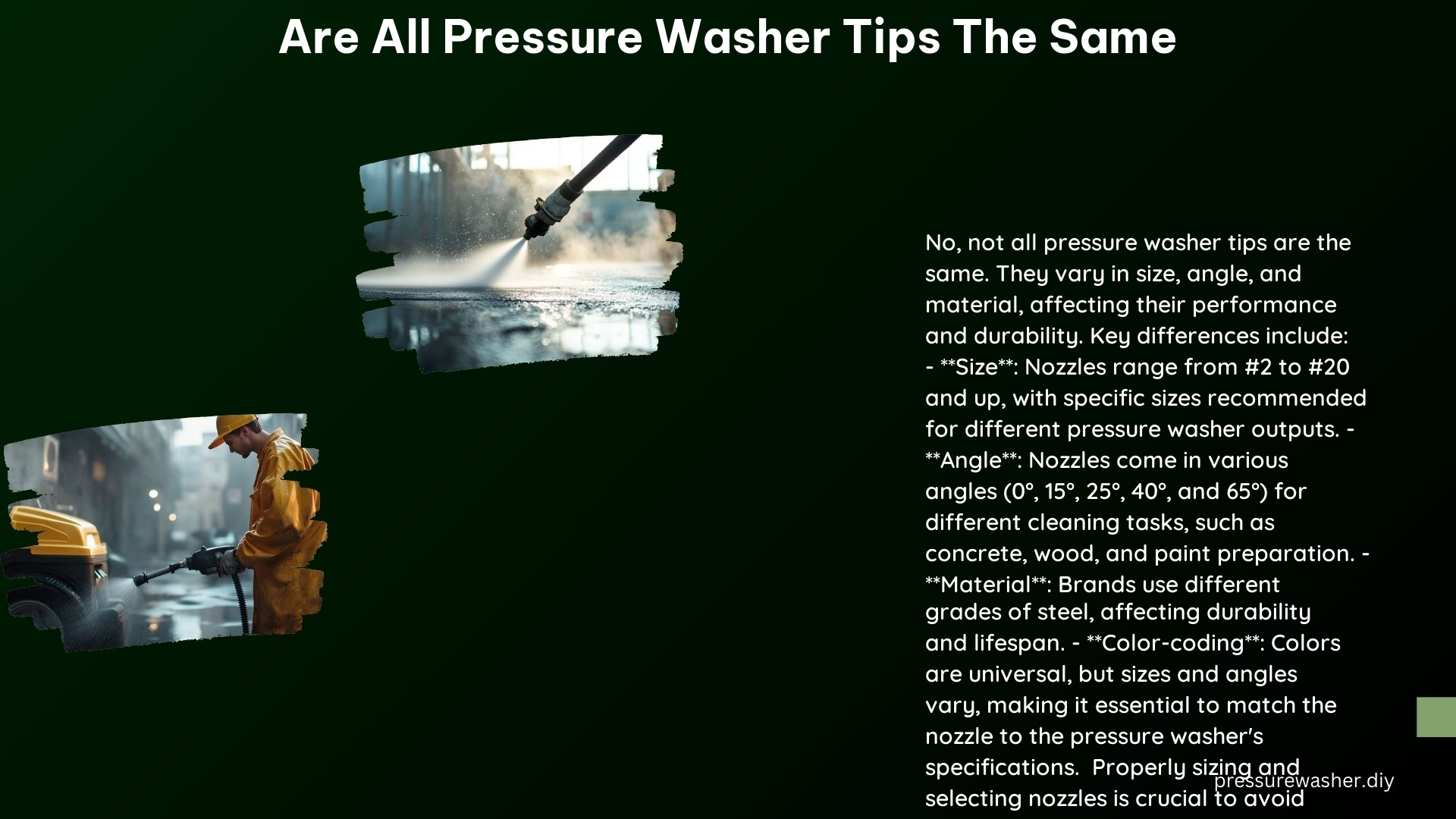Pressure washers have become an essential tool for cleaning a wide range of surfaces, from driveways and patios to vehicles and outdoor furniture. However, not all pressure washer tips are created equal, and understanding the differences between them is crucial for achieving the best cleaning results. In this comprehensive guide, we’ll delve into the intricacies of pressure washer tips, exploring their various types, sizes, materials, and how to choose the right one for your specific cleaning needs.
Types of Pressure Washer Tips
Pressure washer tips come in a variety of shapes and sizes, each designed to tackle different cleaning tasks. Let’s explore the most common types:
-
0-Degree Nozzle (Red): This nozzle has a small, circular hole that produces a thin, high-pressure stream. It’s ideal for cleaning small, heavily soiled areas, such as concrete surfaces with encrusted dirt or grime.
-
15-Degree Nozzle (Yellow): With a narrow spray pattern, the 15-degree nozzle is well-suited for washing hard surfaces like concrete or asphalt. It can effectively remove dirt, grease, and other stubborn contaminants.
-
25-Degree Nozzle (Green): Featuring a triangular spray pattern, the 25-degree nozzle is perfect for cleaning large, tough surfaces like stone or brick walls. Its wider coverage area makes it efficient for tackling broad cleaning tasks.
-
40-Degree Nozzle (White): This nozzle has a wide spray pattern, making it ideal for washing softer surfaces such as wooden and composite decks, house siding, or vehicles. Its gentler spray is less likely to cause damage to delicate materials.
-
65-Degree Soap Nozzle (Black): Designed for applying soap or detergent, the 65-degree soap nozzle has a large central hole that produces a wide, low-pressure spray. This allows for effective coverage and even distribution of cleaning solutions.
Sizing and Compatibility

Pressure washer tips come in a range of sizes, typically denoted by a number, such as #2, #4, #6, and so on. These numbers correspond to the size of the orifice (hole) in the tip, which determines the flow rate and pressure output.
It’s crucial to match the tip size to the pressure washer’s specifications to ensure optimal performance and avoid potential damage. Using a tip that is too small can lead to excessive pressure, while a tip that is too large may result in insufficient cleaning power.
In addition to size, the material of the tip also plays a role in its durability and resistance to corrosion. Stainless steel and brass are common materials used in pressure washer tips, with brass being more resistant to corrosion but potentially less durable than stainless steel.
Usage and Maintenance
Choosing the right pressure washer tip for the job is essential to achieve the desired cleaning results without causing damage to the surface. Consider the following factors when selecting a tip:
- Surface Type: The surface you’re cleaning, whether it’s concrete, wood, or delicate materials, will determine the appropriate tip. Softer surfaces generally require a wider spray pattern, while harder surfaces may benefit from a narrower, higher-pressure stream.
- Pressure Washer Specifications: Ensure that the tip you choose is compatible with your pressure washer’s output. Consult the manufacturer’s recommendations or refer to the pressure washer’s manual to ensure a proper match.
Replacing pressure washer tips is a straightforward process, typically involving a quick-release fitting on the wand. Simply retract the fitting and slide in the new tip.
Regular maintenance of your pressure washer tips is crucial for their longevity and optimal performance. Inspect the tips for any signs of wear or damage, and clean them periodically to remove any debris or buildup that may affect the spray pattern.
Brands and Quality
The quality and durability of pressure washer tips can vary significantly between brands. Some manufacturers may use higher-grade materials, such as stainless steel, which can provide longer-lasting performance and resistance to corrosion.
In addition to standard tips, some vendors offer specialty tips designed for specific cleaning tasks or to provide enhanced performance. These specialty tips may be more expensive but can be worth the investment if they better suit your needs.
When selecting pressure washer tips, consider the brand’s reputation, customer reviews, and the overall quality of the product. Investing in high-quality tips can pay off in the long run, as they are less likely to wear out or become damaged, ultimately saving you time and money on replacements.
Conclusion
In conclusion, pressure washer tips are not one-size-fits-all. Understanding the different types, sizes, materials, and their intended uses is crucial for achieving the best cleaning results. By carefully selecting the right tip for your specific cleaning needs and maintaining it properly, you can ensure the longevity and optimal performance of your pressure washer.
Remember, the key to effective pressure washing lies in the details. Take the time to explore the various options available and choose the tips that will help you tackle your cleaning tasks with ease and efficiency.
Reference:
– Pressure Washer Tip Sizes and Types Explained
– Pressure Washer Nozzle Guide: How to Choose the Right Tip
– Pressure Washer Tip Buying Guide
